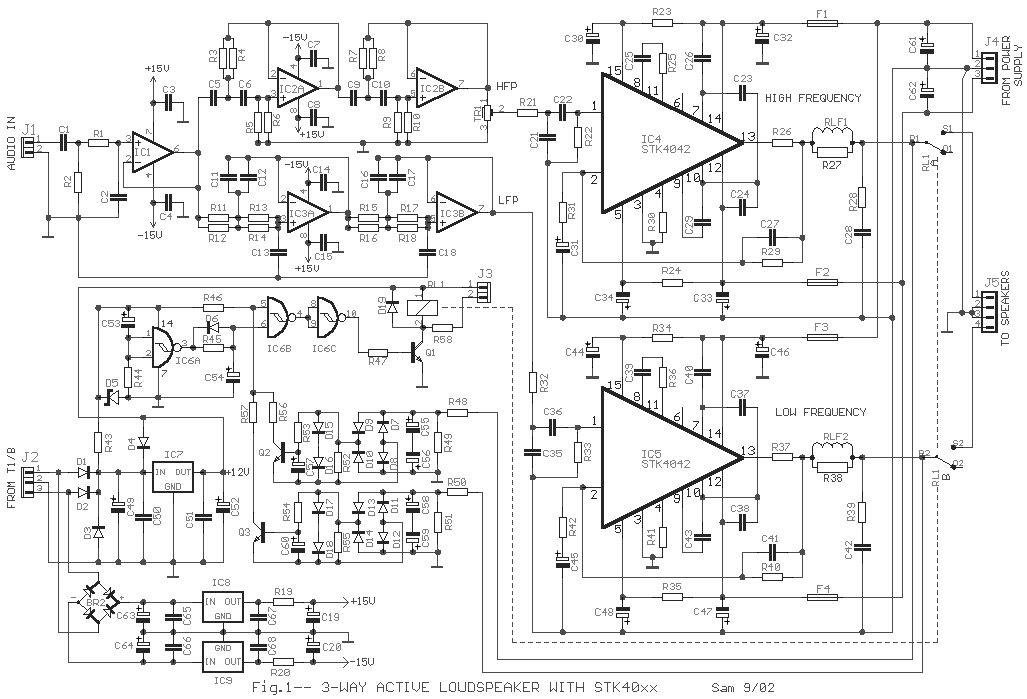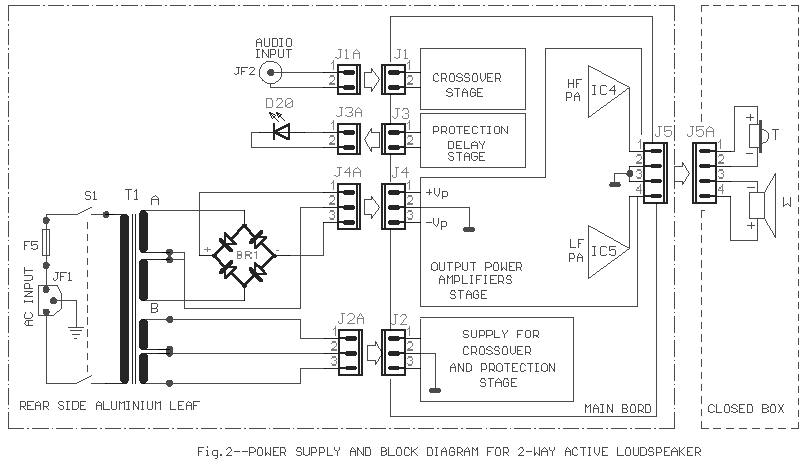Active
loudspeakers have a lot of advantages concerning simple loudspeakers that use passive
components for the elements concretisation of segregation of frequencies. In the case of
active loudspeakers we have, proportionally, bigger build cost, because each loudspeaker
is led by his own power amplifier. In properly drawn active loudspeaker, the quality of
sound is much better and the distortions very low, because it does not use inductors and
large capacitors in the road of signal. All capacitors exist in the signal road, they have
very small value and they are very good quality. This does not mean that one well drawn
passive loudspeaker is not good, perhaps better than one active. On the contrary one
active loudspeaker is enough difficult in the manufacture. In the [Fig.1], exist a circuit
of 2-way active loudspeaker. As we see also in the Block diagram [Fig.2], exist one
classic 2-way crossover with cross frequency fc=3100HZ [-24dB/oct]. This frequency was
selected, because it is near in the cross frequency of many speakers of trade, it can
however change and be adapted in your own speakers choice, it�s enough you use the types
that give for calculation [Fig.3]. The IC1 makes the input adaptation, the filters round
the IC2 creates a high-pass filter of frequencies, for frequencies above Fc=3100HZ, on the
contrary the components round the IC3 creates a low-pass filter, for frequencies under
3100HZ. With the trimmer TR1 in the line of high frequencies we can adaptable, if it
needs, the level between the two speakers. Usually it will need we lower at 10% the level
tweeter concerning woofer. In a lot of points of filter exist capacitors and resistors
that are not used, but are there for future changes, in a other cross frequency, as the R6
and R10 that are not used. To the next stage the two outputs of filter are drive to the
two power amplifiers, the IC4 for the high frequencies and the IC5 for low. Those of are
two hybrid IC by Sanyo, with output power 80W/8ohms, with very good characteristics and
sound. It can become change with other type of series as STK4036, STK4038, STK4040, with
proportional modification of power supply voltage. The particular line is used in enough
active loudspeakers, with very good results. Good it�s used type STK4042XI,
because it has more modern internal designing, concerning type STK404II.
Filters RLF1-2 in the exit of amplifiers are constituted by resistor R27 or R38 and a
inductor wounded round this, in three layers. The inductor is made with 25 until 30 coils
of cupreous wire, diameter 1mm. In the amplifiers output exist the contacts of relay RL1,
who is checked by the protection from DC and delay system. This circuit is found round the
IC6 and works as follows: When the circuit is supplied exist a delay 5 sec in the
connection speakers above in the amplifiers outputs, so that are not pass the charge
capacitors noises. On the contrary when we break the power supply, then RL1 disconnect
very fast the speakers from amplifiers, so that is not heard the discharge noise of
capacitors. At the same time the circuit protects the speakers from DC voltages, that will
be presented for any reason, in the output Of power amplifiers, opening the contacts of
RL1 and disconnect, very fast the speakers. The circuit operation of protection/ delay
becomes obvious from Led [D20], which should be placed in obvious point in the speakers
box. The connections it appears in the Fig. 2. The transformer is toroidal, good quality.
The main pcb, the heatsink, the transformer, the rectifier bridge BR1, as also all the
components that appear except main pcb, are placed in a aluminium piece of suitable
dimensions which is adapted in dimensions of the speakers box and is placed in the back
side of box. Two power amplifiers IC4 and IC5 clinched above in the heatsink. The total
performance of loudspeaker depends always from the characteristics of units Tweeter and
Woofer, that will be used in this, also from the designing and the quality of the box.
Older i used in the place tweeter the T33� and woofer the B200G by KEF.
|


